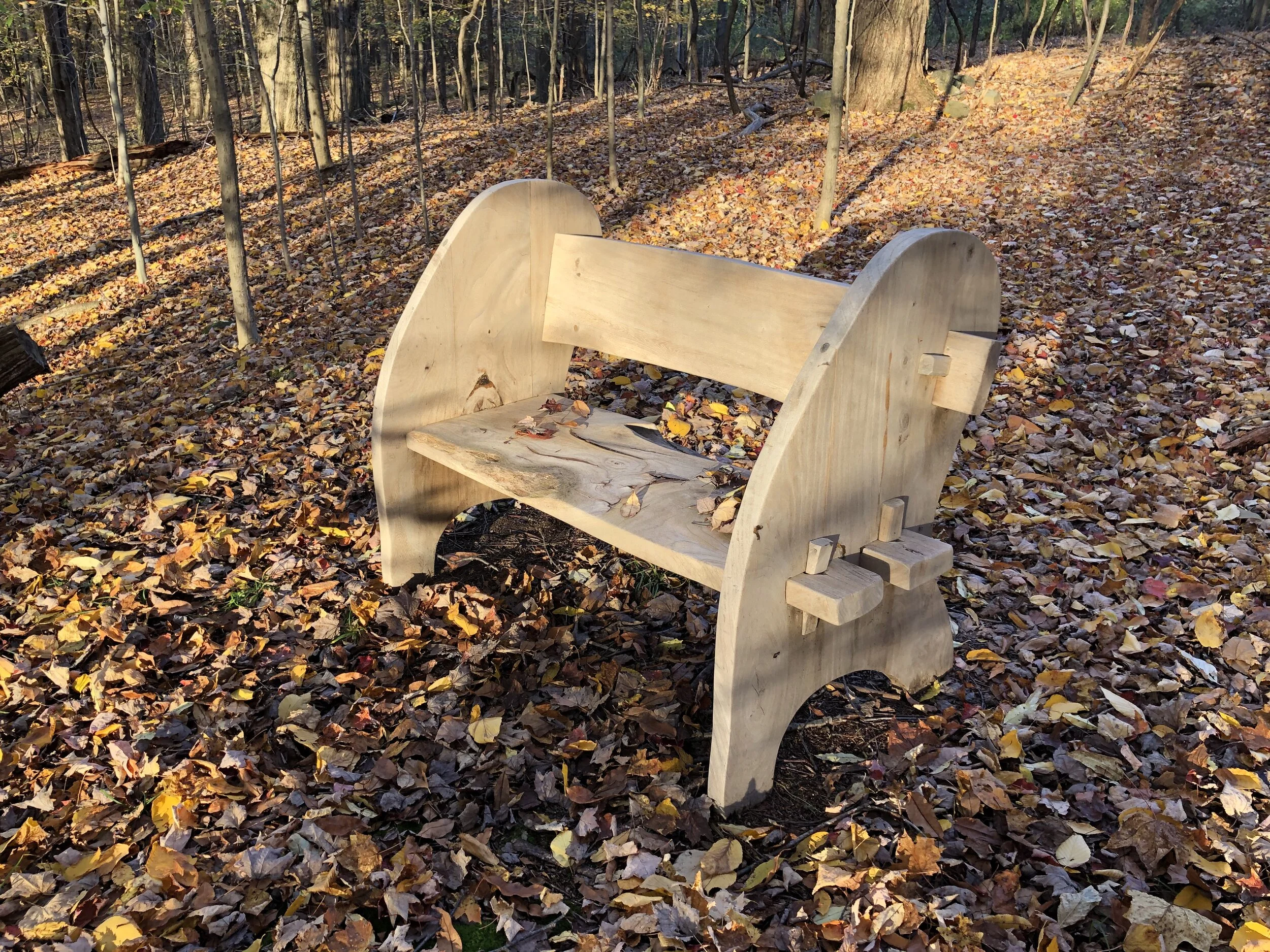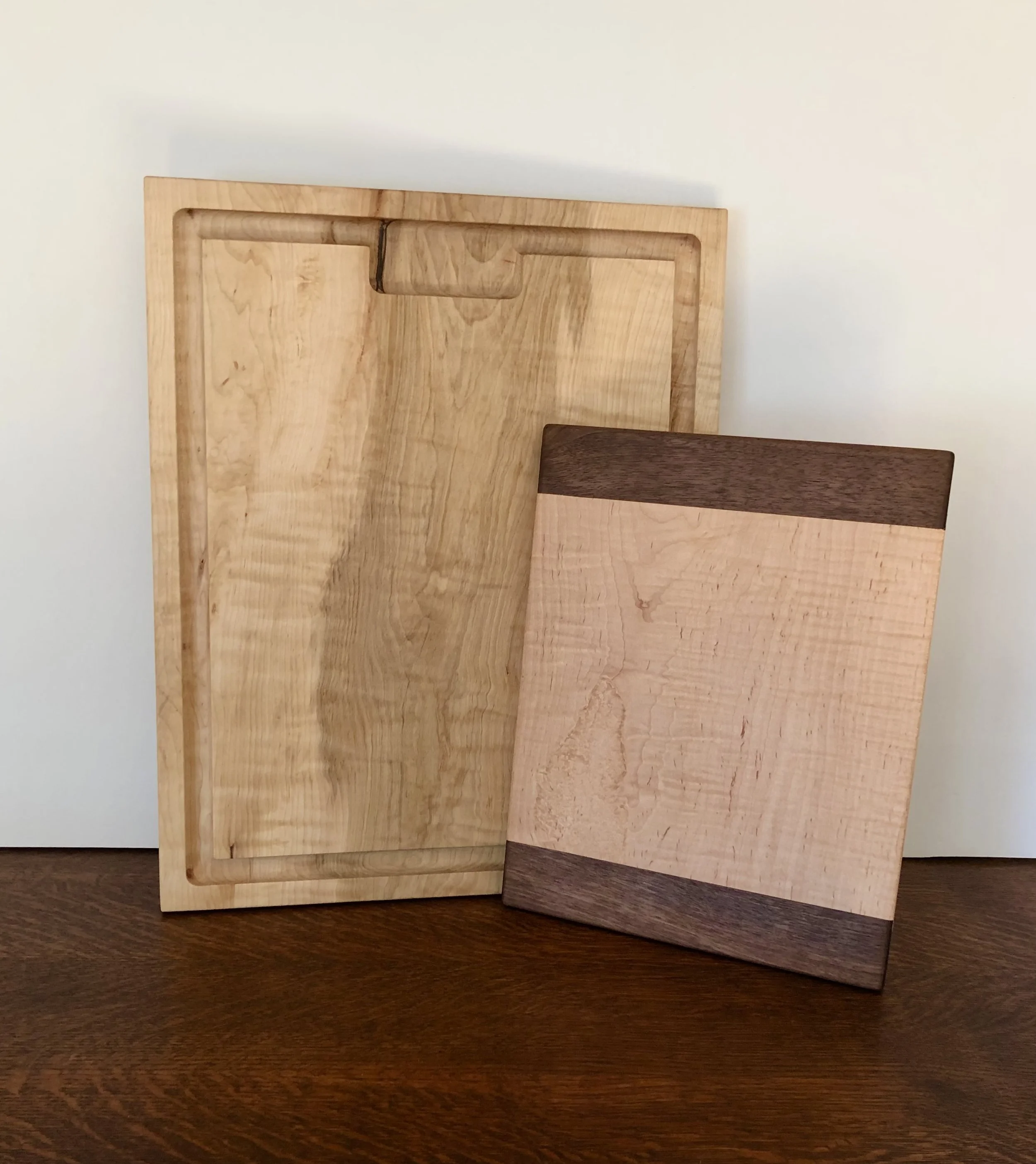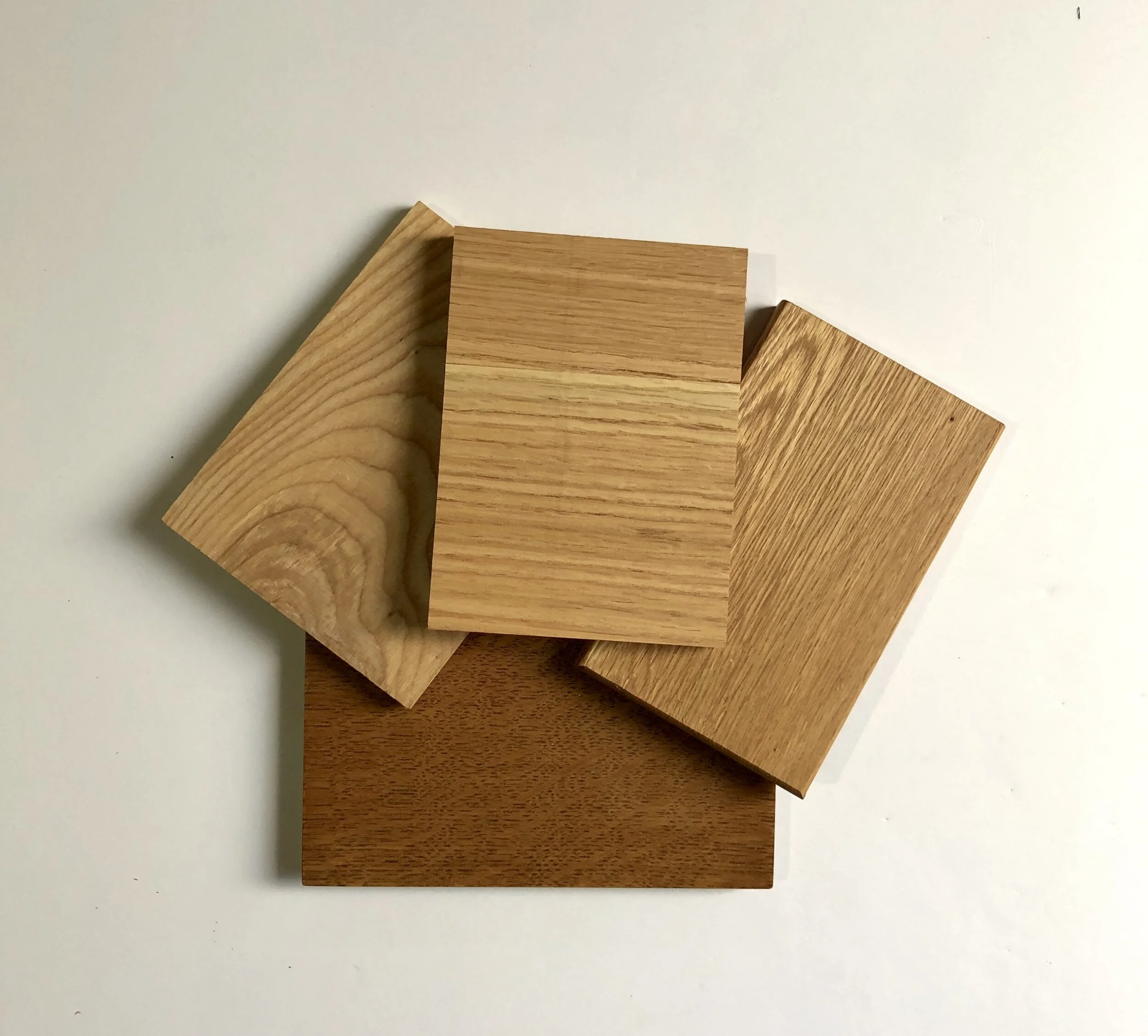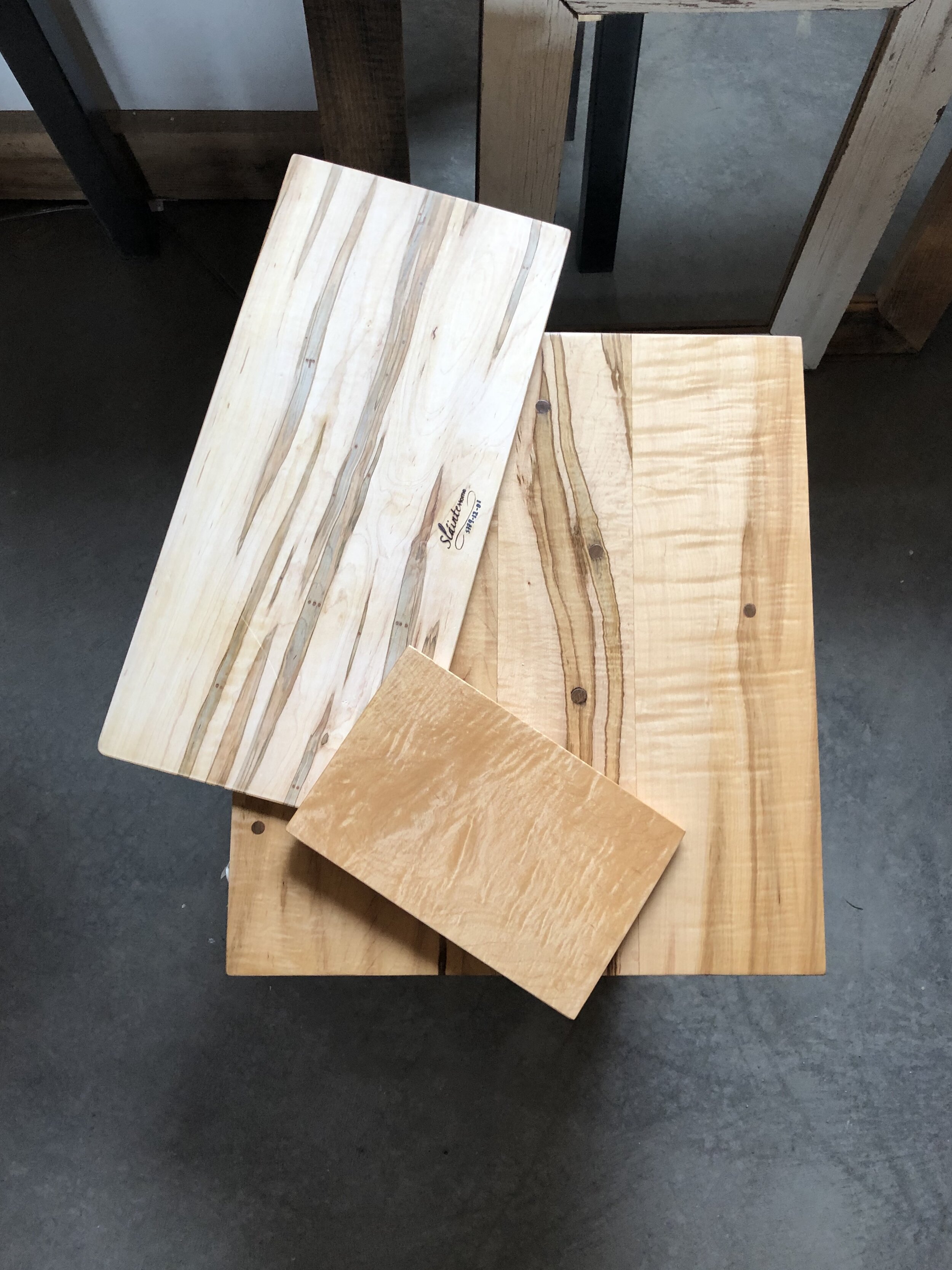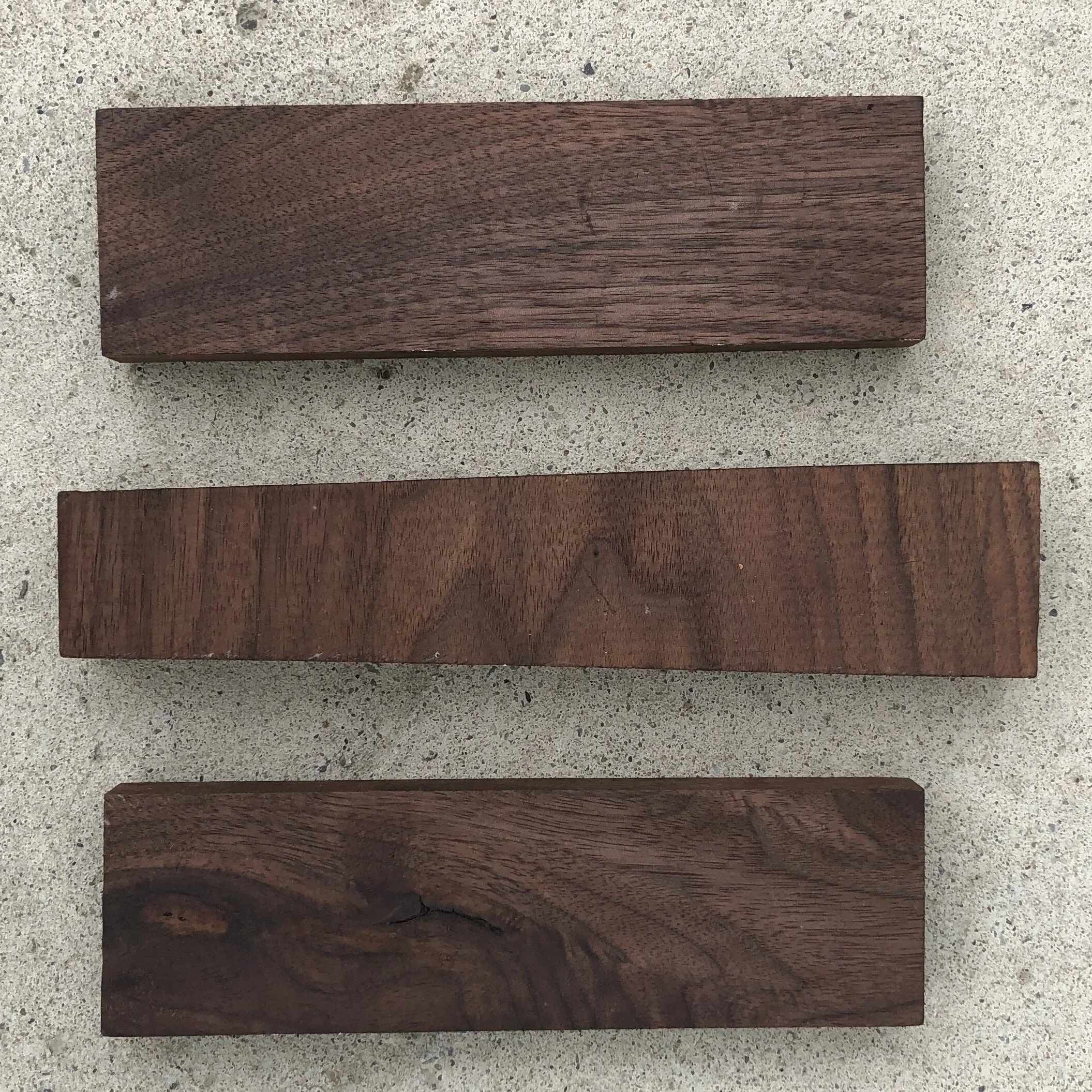Recently we were asked to make a Parsons Table for a client that needed it for a particular spot in their home. We were fascinated to learn about the history of the design. I always thought it hardly looked like a table a “Parson” would use. Way too modern looking. My research led me to discover that I had the wrong “Parson”. The name actually refers to the Paris Atelier where it was first designed in the 1930’s. It’s specifications are that the 4 legs are square in cross section, flush with the edge of the top, and equal to it’s thickness. Normally we would not consider plywood as one of our main building materials, but finished plywood worked out beautifully in this case. The homeowners chose cherry plywood with walnut trim. The results speak for themselves.
Cranberry Salsa
In keeping with the season here is a great recipe for Cranberry Salsa. It is shown being served on a Walnut Slab with retained bark and live edge.
1 bag fresh or frozen cranberries 1 apple peeled,, cored and sliced
1/2 red pepper 1/2 red onion
1/4-3/4 sugar 1/3 cup apple juice or cider
3 Tbsp. fresh cilantro 1 small can of chopped green chiles
1 tsp. grated lime zest
Chop cranberries, apple, red pepper, and onion in food processor. Stir in remaining ingredients until well blended.
Irish Travellers
No, the Irish Travellers no longer use caravans like these, but at one time they did. Nowadays they prefer trailers or caravans as the Irish call them. I came into contact with this fascinating ethnic group when I worked for the Irish Health Service as a pediatric therapist. Because the Travellers are a fairly closed genetic group, they have a higher incidence of genetic disorders and their children often require special therapy services. My Irish colleagues told me that the Travellers originated as Irish displaced by the occupation of Ireland by Cromwell in the 17th century. However, no one really knows how they arose other than that they are not related to the Roma of Europe. The Travellers have a traditional culture with most people marrying young, women staying at home, and men providing the family income. Many Traveller children often leave school young or attend only sporadically. Their poor school attendance was a constant source of frustration for the teachers and school administrators I worked with. In my experience, almost all the men were self employed, engaging in a variety of jobs that some Irish regard as questionable. There was definitely some prejudice or dislike of the Travellers among the general population. The Irish government provides a wide variety of services and protection for the Travellers and this is also a cause for some resentment. Where we lived in the Midlands there was a large Traveller population and as the weather warmed we would often pass Traveller caravans on our evening walks. They have the legal right to park in places where they traditionally have camped.. This sometimes caused some grumbling among the local farmers who regard them as trespassers and annoyances. The Travellers are known for their involvement with anything to do with horses. Driving home we would often pass young Traveller boys on sulkies, driving their painted Irish Cobs. I felt lucky to get to know and interact with such an interesting people that maintain their traditional ways although with a nod to modern conveniences.
ABC's of Cutting Boards
Which cutting board is right for you? There’s probably a gazillion choices for cutting boards out there. Of course, we think our cutting boards are the best and here’s why. Our boards are basically made from one wide board. Except for the bread board ends, shown here on the smaller board, SlainteHome cutting boards are made from one piece of hard Maple. This eliminates the cracks or seams where food may collect and where other boards tend to crack over time. Whether you choose a board with channels or not, the choice is up to you and how you plan to use it. We use plain old mineral oil to finish our boards. This can easily be purchased as the grocery store or pharmacy. How often do you need to freshen your board with the oil? It depends on how often you use it. A good rule of thumb is that when water no longer beads up on your board it’s time to give it a coat of oil. To clean your board just rinse under a cold tap and wipe dry. If you want to sanitize your board use 1 tablespoon of chorine beach to a gallon of water.
Why Dry Matters
Many people approach us with a story similar to this one; “We just had a giant Oak tree fall down in our yard. Our children played under it for years. We would like you to make a table from it as a remembrance.” Easier said than done! Most people only have some vague idea of what it takes to convert a fallen tree to lumber. The logistics of cutting, moving, assessing for rot in a downed tree is a story for another blog. What is critically important is that wood has to be dry before it can be used. After a tree comes down it can either dry “as is” or be cut into boards. It must be dried either by air drying or kiln drying. People ask, “Well how long will that take?” There is no easy answer to that as it depends on the species of wood, the humidity in the environment, and the thickness of the wood. We use a moisture meter to tell us when our wood is ready to be used. Wood dry enough for use is generally considered to be ready for use in the “low” (under 12%) range. If wood is not properly dry it can split, warp, or “move” (shrink or expand). So next time you want to save that old Oak tree, consider the costs involved in moving, cutting, milling, and drying it. Then wait until it’s nice and dry and give us a call!
Caprese Salad for Late Summer
You have to make a classic Caprese Salad at least once when fresh tomatoes are in season. It’s super simple to make. Start by slicing a fresh tomato and salt to reduce the tomato liquid. Slice up a nice ball of Mozzarella. Arrange on a Serving Platter and top with torn fresh Basil leaves. Sprinkle with a coarse salt and a drizzle of olive oil. Doesn’t get much better than this!
Want To Know More About Ohio Hardwoods - Oak and a Few Others
Too often when people think of Oak they think of the “Golden Oak” ubiquitous furniture popular at the turn on the 20th century. Actually, Oak was considered a secondary wood until furniture makers were forced to turn to it when all the American Walnut, Cherry, and other “fine” woods had been harvested. The most common types used in woodworking are the Red and White Oak. A Red Oak piece is shown in the center of the picture, with White Oak to it’s right and Ash on it’s left. The piece on the bottom is quarter sawn White Oak with a Provincial Stain, showing the characteristic “flecks” seen with quarter sawing. The hardness of the two Oaks is similar with White Oak being slightly harder (Janka 1350 vs. 1220 for Red Oak). New White Oak can sometimes have an olive cast and usually needs some additional staining to give it a more appealing look. The piece shown is a reclaimed piece with a natural stain. White Oak is generally considered more durable while Red Oak often has a more attractive color. Red Oak has a wider, more open grain than White. Related to the Oaks are woods like Ash (shown above), and Hickory.
Want to know more about Ohio Hardwoods-Maple
Maple trees are probably the most common tree you will see in Ohio. We use Hard Maple, also called Sugar Maple to make our products. The hardness is about 1450 on the Janka scale. These are the same trees that are tapped in the Spring for Maple Syrup. In fact, we make furniture and other pieces from “Taphole Maple” where the holes from sugaring are actually present. We usually plug the holes with contrasting Walnut which makes the boards very attractive. The picture above shows three types of grain you can get in Maple. The Taphole Maple is on the bottom. Shown on top are “Ambrosia” and “Tiger”. These describe the grain and are not different types of trees. Maple is sometimes overlooked for furniture as many people remember it as that old Colonial Maple from the 1950’s. Hard Maple today is prized for it’s beautiful and varied grain figurings.
Want to know more about Ohio Hardwoods - Walnut
We could easily write a book, well, maybe a long article, on the different characteristics of our native hardwoods. So….let’s start out with an easily identifiable wood; WALNUT. Shown below are several samples of Walnut. The first thing you will notice is it’s dark color. It makes beautiful furniture. It’s harvested locally which makes it a good environmental choice. It’s wood density is around 640-700, which definitely puts it in the hardwood category. If choosing Walnut you should be aware that it tends to show cuts on it’s surface more than other woods just because it is so dark. That’s why you usually don’t see it used for cutting boards. Using Live Edge Slabs of Walnut for tabletops is one of it’s most popular uses.
Traditional Irish Brown Bread
If you have ever been to Ireland you will know that almost every restaurant serves a delicious brown bread. It’s often served with smoked salmon. I found this recipe years ago and it is remarkably like the brown bread served in Ireland.
Read moreAdding Interest to Your Flower Beds
Sometimes something serendipitous occurs when rummaging through the log pile. This small Ash log just needed to be made into a Planter to set out in the garden. It had a natural declivity perfect for holding a small plant. It needed some sanding and a water resistant stain applied to be used outdoors. It is holding a small strawberry plant. The finished product looks like it would be at home in Bilbo’s Garden in Bag End.
Spring Gardening
There are lots of things you can plant this time of year. Gardening has many benefits; you’re outside, you can do it alone, you’re getting exercise, and best of all you get to enjoy the fruits of your labor. There is something very satisfying about being able to eat what you have personally grown. Things you can grow this time of year are lettuce, radishes, spinach, onions, peas, and carrots. Radishes are a good choice for children to plant as the seeds are relatively large and they grow quickly. You can be eating your radishes in about 25-30 days. Veggies can be grown anywhere, you don’t need an elaborate garden. Plants can even be grown in existing flower beds or in containers. You can buy seeds at a local garden shop or hardware store. It’s a good idea to buy major brands like Burpee as you will get a better percentage of seeds that sprout. So get out there and start to grow your own salad fixings!
What's New at SláinteHome
We have been getting organized and thought you might want to too!
We have been working on designing the perfect chalk board for almost a year. How do we make a workable surface? Where do you keep the chalk and eraser? What size is best? Well they are finally ready to roll off the SlainteHome production line. We have also added cork boards for home or office use. Our cork is extra thick: almost 1/2” with a variety of natural and reclaimed wood frames.
Mmmm..........
Today I took my son-in-law to Gallucci’s. Never been there. Who can resist their fabulous cheese selection? Tonight for starters we will be enjoying our finds presented on a Walnut SlainteHome serving board. Doesn’t get much better than this. Slainte!
Thinking Spring
This is the time of the year when I start looking to see if the Pussy Willows are starting to come out. Seeing them, gives you hope that Winter is on the wane and Spring will be coming. We are excited about all the new things that will be happening at SlainteHome this year; new products, more events at our Barn, new venues, and unexpected adventures that await us. We give a New Year Shout Out to all our loyal customer/friends, and look forward to making new ones in 2019. Deborah and Leo
Grand Opening at the Wright & Rede Studio
Join us for the Grand Opening of Our New Studio space this Friday, June 29th.
SlainteHome is excited to announce that we are opening a Co-op Studio with Wright & Rede, makers of fine, hand-stitched leather goods.
A variety of SlainteHome furniture and accessories, along with Wright & Rede’s handcrafted leather goods will be available in the studio at the historic Heights Rockefeller Building in Cleveland Heights.
You no longer need to wait to see new items at the next Cleveland Flea or other area shows.
After the opening we will be available by appointment and during planned Open Studio days. Contact SlainteHome by email at Debby@SláinteHome.com.
We will have a few new items as well as a noteworthy announcement. If you plan to attend please send us an email to Debby@SlainteHome.com, so we can plan accordingly.
SlainteHome and Wright & Rede Grand Opening
- Friday June 29, 2018
- 3019 Mayfield Road Suite 216, Cleveland Heights at the corner of Lee and Mayfield.
- 5:00pm - 8:00pm
There is a parking lot in front of the building and a much larger parking lot at the East side of the building.
Hope to see you there.
Slainte,
Debby and Leo
Pole Beams from an 1845 Home
Recently we were excited to find a collection of old reclaimed barn wood stored in a barn in Middlefield. Included in the stash were pole beams up to 16' long from an 1845 home.
Needless to say, we bought the whole lot. It is all now in our SlainteHome barn. Some of the reclaimed wood we will use for building furniture and accessories. Some of the wood will be used for special built-in features like beamed ceilings, fireplace mantels, kitchen islands, and bathroom vanities, etc.. But we do have more than just a bit of it, so some of the wood is for sale now by appointment.
We have started moving all the wood we have into our new barn and work shop as well. Some is reclaimed in addition to the wood mentioned above. It ranges from old 2x4's that framed walls to structural beams. Other wood in the barn is the high character wood that you see in the items we make. Most of it is in slab form. Some has live edge some does not. It has been in the barns of various friends while we were building our barn.
So if you want something custom made we have a good selection for creating your special something. Please contact us with any questions.
All the best,
SlainteHome
Plain Dealer write up about SlainteHome
There is a write-up in Cleveland.com about SláinteHome. It was written by Allison Carey the Plain Dealer Style & Fashion Reporter. We thought you might like to read it. It made us more than just smile. We downright enjoyed it.
As any entrepreneur knows, it is a long way from the first idea, to a business that works. Everyone would agree that it is a lot of work. But most will agree that it is an adventure worth taking. It is the thrill that comes from following your bliss.
Our goal from the beginning was to make special things for special people and special occasions.
Of course we could not continue to do what we do without the support of all of you.
Sláinte!
Deborah Abramson & Leo F. Lee, SláinteHome
Fantastic Wood Find
In our most recent adventure we found some great reclaimed wood. Hidden among the stacks of lumber was some old Wormy Chestnut. The great Chestnut blight of the 1920's killed off all the American chestnut trees that populated our Northern Forests. Under the weathered gray exterior that you see in this picture is some beautiful wood. The warm brown color of this chestneut is highly prized. It would make someone an unbelievable dining or conference table. Just couldn't resist sharing.
Waiting on Spring
Poor babies. The Dutch sweethearts are hoping for warmer weather by Valentine's Day. It's been rough on them but the cold, snowy weather has given us a chance to add new pictures and content to SlainteHome.com. There are probably lots of new items you haven't seen. Keep on checking as we will be adding many new pieces, especially furniture in the next few weeks.
Slainte, Deborah

